R. Mark Liebenow's Blog: Nature, Grief, and Laughter, page 10
October 4, 2015
Brother Sun, Sister Moon
 The feast day of Francis of Assisi is October 4. In this harvest season, as I drive through the countryside past golden fields of corn, I think of Francis and his great love for nature.
The feast day of Francis of Assisi is October 4. In this harvest season, as I drive through the countryside past golden fields of corn, I think of Francis and his great love for nature.I see him running through the fields of his scenic Umbrian countryside, robe flapping around him as he shouts his words of praise — lyrics about glorious flowers, singing birds, and the glowing fields of wheat. In what would come to be known as his Canticle of Creation, Francis praises the beauty and presence of the natural world and all its creatures, and gives thanks for his companions, brother Sun and sister Moon. Except that Francis actually began this poem not when he was out in the fields being inspired. The words came when he was seriously ill and lying in bed. How was he able to sing praises of joy when he felt so horrible that he couldn't get up? When I’m sick, praise is the last thing on my mind. I am truly a horrible patient.
Already in exile from his home and family, after days of being cold and shivering, perhaps the words slipped into his consciousness when a single ray of warm sunshine touched his skin, like the comforting touch of a friend.
Rather than moan about his suffering, he celebrated this simple pleasure and gave thanks for this.
Published on October 04, 2015 05:58
September 27, 2015
Sweetness of Living
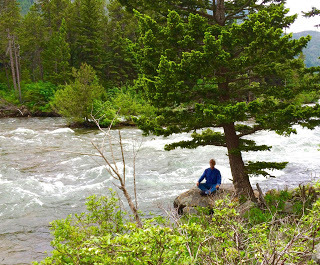 Native life in the barren Arctic is a constant battle to survive. To the Inuits who live there, the brutal struggle to stay alive is balanced by the sweetness of living. A long life is never assumed, not even an additional year. There was gratefulness for what each day provided. For them, it was not enough to survive if they did not also find something to celebrate.
Native life in the barren Arctic is a constant battle to survive. To the Inuits who live there, the brutal struggle to stay alive is balanced by the sweetness of living. A long life is never assumed, not even an additional year. There was gratefulness for what each day provided. For them, it was not enough to survive if they did not also find something to celebrate. My great grandparents felt the same way, I think. Life was hard when they moved to Wisconsin in the late 1800s and created a farm in the prairie wilderness. Yet the physical life and the fresh food they grew helped them live long lives.
Being in the wilderness centers me. It connects me to the land and its spirituality, what runs through the roots of the trees, shines in the eyes of its creatures, and sings in the melodies of the birds and the howls of coyotes. Its power surges in the rivers and claps its hands in the booming of the thunder.
Gratitude is not based on what I don’t have. It’s giving thanks for what I do.
Published on September 27, 2015 06:13
September 20, 2015
The Wilderness is Home
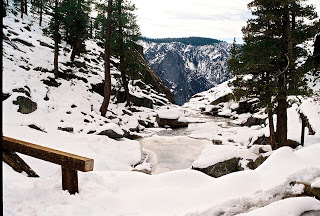 (The top of Yosemite Creek as it goes over the falls.)
(The top of Yosemite Creek as it goes over the falls.)This is where it began. In the snow. My journey in Yosemite began in the snow one winter. And I could not believe that such a place could exist.
I grew up in the woods, on the rolling hills and lakes of Wisconsin, reading the words of John Muir, Aldo Leopold, and Sigurd Olson. When I moved to the Bay Area in California, and the urban landscape of endless buildings and highways, I lost touch with the outdoors.
When a friend took me to Yosemite, I entered the place that John Muir describes in his books, and I was stunned by what I saw. I return to Yosemite whenever I can to be renewed by the fresh air, hiking up the mountains, and the quiet sounds of sitting in undisturbed forests.
I sit by the rivers and listen to the surging water, watch deer and coyotes play in the meadows, look for owls, hawks, and ravens in the sky. Often I see bears as I hike, and sometimes I glimpse mountain lions moving through the shadows.
Yosemite inspires me with the power of its many waterfalls, the great granite domes, and the giant sequoias that rise up 300 feet and are 3000 years old. Sunrise and sunset often fill the sky with yellow, orange, and red. From the warm, green fullness of summer and the cool brown days of autumn to the quiet trickling of snow-clad rivers in winter, each season holds its own beauty.
When I am in the wilderness, the rush of daily life slows. I have time to think about life back home and work through its complications. By camping, I renew a relationship with nature and learn to hear its many voices. Often I feel awe as I hike the trails between the great vistas, and sometimes I feel fear, for this is still the wilderness, and it has its own rules that I need to respect.
When I look over the seven-mile length of the valley as a winter storm clears and light brightens on the horizon, mist rises from between the trees of the dark green forest, drawing me from the visible world into the mystery that is hidden within.
*
I have a video with many of these words on YouTube. Created with Kevin Hall, it uses photography from my hikes and music by Lindsay Adler. On YouTube, type in “Liebenow Yosemite” and the video will come up. Or use this link: http://www.youtube.com/watch?v=7YU61Cy2lio. There are two versions – one with captions, and one without.
Published on September 20, 2015 05:45
September 13, 2015
Yosemite Tree Notes
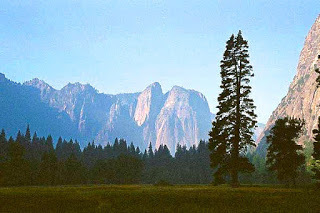 This week, forest fires are burning in Yosemite and threatening groves of giant sequoias.
This week, forest fires are burning in Yosemite and threatening groves of giant sequoias.In the late 1800s Sir Joseph Hooker said he had never seen a coniferous forest that rivaled the Sierra's because of the grandeur of its individual trees and the number of its species.
The Ahwahnechee and their ancestors lived in Yosemite Valley for hundreds of years. Acorns from black oaks made up 60 percent of their food.
The prime growing area for the ponderosa pine is in the Sierra.
For the last 140 years, trees in the meadows of Yosemite Valley have been in flux. Black oaks love moist earth and need fire to thrive, which they don't often get today because of human fire suppression. Pines and cedars like dry earth and suffer root-rot when there’s too much moisture in the ground.
When the settlers drained the swamps in the valley in the late 1800s, pine trees began replacing the oaks, and a crucial source of food for the Ahwahnechee was greatly reduced.
The pioneers also replaced a community and its sustainable way of life with hoards of tourists, creating a place of noise and commerce. Yosemite is also a place where millions of people come each year to experience the awe of nature and the wilderness. Many come to heal, calm their demons, and find strength and guidance for their lives back home.
When I’m in Yosemite, at dawn I often walk into the coolness of the meadow with a cup of hot tea and stand by my favorite ponderosa. I look up at the mountains catching the first rays of light, and feel the warmth of the sun flow into the valley. I think about all the people through time who have stood on this spot — the Ahwahnechee who no longer call this valley home, the pioneers who are also gone, and the people who come today to be alone with nature.
I am heartened by people returning to nature seeking wisdom and inspiration, but I grieve what has been lost.
Published on September 13, 2015 06:03
September 6, 2015
Until Every Land
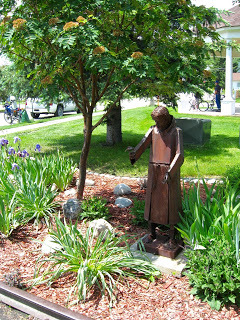
(photo of a statue of Saint Francis)
“Until Every Land is Covered by Tranquility,” my short essay on a peace demonstration, was published this week at Mindful Matter. (You can read it at: http://hlst.ee/1N0wx1L)
That it was a protest against nuclear weapons in Berkeley, California is not unusual. That it was peaceful is affirming. That it was led by seminarians and faculty from nine Protestant and Catholic seminaries is notable because too often religion is silent on matters of ethics when society is for the status quo.
The demonstration took place in 1980, which is halfway between the bombings of Hiroshima and Nagasaki in 1945 and where we sit today. This year, on the 70th anniversary, there was another protest. This means that politicians and the military still like their big, bad toys, like easy answers instead of lasting ones, that our work continues, and that we still don’t trust them to tell us the truth.
What touched my heart about our protest in 1980 was the presence of Japanese nuns of the Buddhist Lotus Sutra sect. One of their traditions is to beat on drums softly at protests as a way of sharing the peace in their hearts with others.
Later that year, at another protest, I stood beside them in the rain, listening to the beat of their drums and feeling the rhythm of compassion flow into me.
It’s discouraging that the use of weapons to settle differences continues. It depresses me that governments think it’s okay if 20 civilians die for every Islamic insurgent, because the ends never justify the means. It is coming out now, in the middle-of-the-road media, that the U.S. government supported terrorist death squads in Central American that killed off a generation of creative and humanitarian minds from the 1960s to the 1990s, as well as supported dictators before and after that.
This has been known to journalists for decades, but their work has been censored by the corporate media that is more beholden to their shareholders than to the truth.
Yet I am heartened that people continue to protest the backdoor schemes of politicians and the deaths of innocent people for economic gain.
Lasting peace is never achieved by killing. Peace starts with the compassion we feel in our hearts, and expands from there to the hearts of others.
May the beating of the drums remind us of this.
Published on September 06, 2015 05:46
August 23, 2015
Old Wawona Stagecoach Road
 There are special areas in Yosemite that continue to resonate in me because of what I experienced there. I return to them whenever I can. If you want solitude, there are many old, forgotten trails that are away from the summer crowds. This is the account of one hike I took on the Old Wawona Road.
There are special areas in Yosemite that continue to resonate in me because of what I experienced there. I return to them whenever I can. If you want solitude, there are many old, forgotten trails that are away from the summer crowds. This is the account of one hike I took on the Old Wawona Road.Mid morning I’m at the Wawona Tunnel parking lot. A dozen cars are here and people are lined up along the stone wall taking pictures of the stunning view over the forests and up the seven-mile-long granite canyon of Yosemite Valley. In front of us are El Capitan, Bridalveil Fall, and Half Dome in the distance.
I go across the parking lot and start up the Pohono Trail. Twenty minutes later I reach the junction with the Old Wawona Stagecoach Road. Normally I would turn left and follow that trail along the southern rim of the valley to Stanford Point, Bridalveil Fall, Taft Point, Sentinel Dome, and on to Glacier Point.
Today I turn right and continue uphill, wanting to explore what used to be the road that came in from Wawona. The road was built in 1875 over an old horse trail but this section of road was closed in 1933 when the Wawona Tunnel opened. It took over two years to dig and blast that tunnel through the mountain to replace the steep, and somewhat dangerous, section of the old road that had tight switchbacks.
Many of the roads in the valley were built over the foot paths of the Ahwahnechees, which became horse trails, then dirt stagecoach roads, and eventually paved roads.
Half an hour later, a bend in the road brings me back for a moment to the Pohono Trail at true Inspiration Point. I do not stop to look back at the valley. I will do that when I return. This trail road is less congested with fallen trees and wash outs than its counterpart on the other side of the valley — the Old Big Oak Flat Stagecoach Road that was abandoned in 1943 because of continuous rockslides.
It’s a warm day and a cool breeze is coming up from behind me. In a corner of my eyes, I catch the movement of a large bird. It lands somewhere on the other side of a huge boulder. Quietly I inch forward, peering through the gap between the boulder and a tree trunk to find where it landed. On a branch I spot a red-tailed hawk, and it’s watching me. After deciding that I’m not of interest or danger, it looks away. But when I move around the boulder for a better look, it takes off.
In many places, I walk across a soft, crunching carpet of five inches of pine needles and cones that have accumulated over the decades. The even, undisturbed look of the needle cover says that few people ever hike here. In the middle of the road a coleus-type plant grows by itself; the only one of its kind that I can see. A pileated woodpecker, lean and about a foot long, flies by and lands a short distance away. It looks at me as if I have disturbed its solitude. I probably have.
After an hour and a half I reach the overlook near the end of the abandoned road with a magnificent view of the Big Meadow, Foresta with its two barns, and I feel a connection with history. I sit, eat my lunch, and imagine what it was to ride a horse for days up through the hot, dry foothills and canyons and find this meadow, this cool, green meadow, resting for a spell and loading up on fresh supplies at the barns, before heading on the last part of a journey and entering the valley on the riverside trail with the hope of seeing Mr. Muir.
I imagine the sounds of a stagecoach passing behind me — the rumble of its wooden wheels, the clanking of the carriage, the jostle of the harnesses on the horses, and the sounds of their hoofs on the ground.
This landscape probably hasn’t changed much in 140 years. Beyond the nostalgia of history, I feel a presence here, not of any large animal or famous people, but the presence of the mountain I’m sitting on, the presence of the forest, and the presence of a community of small birds that flit through the trees and the squirrels that hop over the ground looking for something to eat. Nothing is awe-inspiring, but if I lived in a cabin here surrounded by all this, I would be so grateful because of the wholeness I feel.
Turtleback Dome is directly below me, on the bend of the current road as it comes out of the Wawona Tunnel. Elephant Rock is out of sight. A short ways beyond here the Old Wawona Road dissipates in the forest.
Eventually I walk back down. The forest is quiet, except for the loud call of some bird off in the distance. There haven't been any other hikers or many scenic moments. As I near Inspiration Point, where the early travelers got their first look at the valley, I keep my head down and try to clear my mind of all the images of what I know are ahead. I want to experience the view as the early tourists experienced it. I want to see what took away the breath of Lafayette Bunnell as he traveled with the Mariposa Battalion.
I concentrate on the images of the landscape where I’ve just been — dry dusty canyons, dark forests that go on and on. Then I look up, and the 3000-foot-tall monolith of El Capitan rises up in full glory. I am speechless that such a wondrous thing could exist in the wilderness.
Published on August 23, 2015 07:54
August 16, 2015
Wilderness Questions
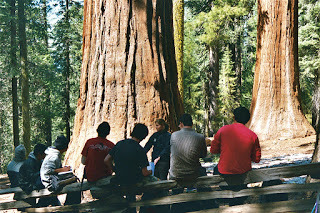 When I sit on the side of a mountain and watch clouds journey across the sky, thoughts come to mind that I like to ponder. Some are whimsical, but others, I’m sure, have profound implications.
When I sit on the side of a mountain and watch clouds journey across the sky, thoughts come to mind that I like to ponder. Some are whimsical, but others, I’m sure, have profound implications.Skyscrapers have been compared to mountain peaks because they’re both tall and massive. When we first see them, we are gob-smacked with awe and admiration. But if we put them side by side, the buildings begin to seem one-dimensional and uninteresting. We can hike into mountains, and they also have forests, rivers, and alpine meadows. And deer, birds, and coyotes, and bears, moose, and squirrels.
Can the great city parks like Central Park in New York City and Golden Gate Park in San Francisco, both designed by Frederick Law Olmsted who was a big fan of Yosemite, ever be a replacement for natural forests? A temporary substitute, maybe. A slice of heaven for people stuck in the city, perhaps. But a replacement? No.
Why do wilderness landscapes that are untouched by humans feel like sacred places? Do we think of them as remnants of the original Eden?
Is any tree as impressive as a giant sequoia? (Don’t answer if you have never stood beneath one.)
Do people need the wilderness to keep their wild spirit alive?
The wilderness was formerly thought of as a forsaken place. Why? Because no humans were around to assign it value? Because the wilderness had no material value that humans could exploit? Because any humans that were there were insignificant specks in comparison to something enormous, beautiful, and perfect?
What unfulfilled needs do national parks address? Did national parks only become good when humans needed to escape from what cities had become?
Today many people find spirituality in nature. Is this because of something that is found in nature, or something that is lacking at home?
Does affinity for the wilderness come from the landscape in which one was born?
Are people who played outdoors as children more likely to fight to protect the environment?
Do people who grow up with four distinct seasons like to camp more than, say, people from San Diego?
If an environment can kill you, does that make it more real?
Does cooking over a campfire, waiting for the sun to rise over the mountains, and watching the stars at midnight make you dream of matters more ancient than your birth?
When you stand alone on the bank of a river when it’s raining, do you feel lonely, thoughtful, or renewed?
Published on August 16, 2015 05:14
August 9, 2015
Adventure of Solitude
 Many of us go into nature to unwind and be refreshed, but when we try to talk to others about how nature is transforming us, we find it hard to express the changes in words.
Many of us go into nature to unwind and be refreshed, but when we try to talk to others about how nature is transforming us, we find it hard to express the changes in words. In Breaking Into the Backcountry, Steve Edwards takes on the challenge of describing this inner movement. He invites us into his days as he takes care of a cabin in the wild backcountry of Oregon for seven months. With no one around, he is forced to deal with the silence, isolation, and unresolved struggles in his life. As John Muir, one of Edwards’s heroes, said, the journey into nature is also a journey into ourselves.
Insights of Thoreau, Rilke, Thomas Merton and others guide him as he adjusts to the solitude and his life intersects with the lives of the deer, bear, and mice. There are keen observations of nature’s changes as it transitions from April to November.
At the beginning of the book, Edwards questions how he is going to cope with living alone. By the middle of summer, lost in the glory of another sunset, so much has happened that he wonders how many other epiphanies he has already forgotten.
This is a book of presence, of discovering foundations. Solitude becomes part of him. Edwards does not arrive at the destination he seeks, but he finds the path that is taking him there, a path of guidance and nourishment.
This is a beautifully written book.
Published on August 09, 2015 05:30
August 2, 2015
Seeing Nature Through a Lens
 (my photo of Half Dome, taken from across Tenaya Canyon)
(my photo of Half Dome, taken from across Tenaya Canyon)Early one morning I followed the Merced River in Yosemite from Happy Isles to the big medial moraine, turned right, and headed up Tenaya Canyon. At the far end of Mirror Meadow I sat on a log by Tenaya Creek. Half Dome began on the other side of the river and rose a mile over my head. My intention was to sit by the quiet river, focus on the triangular boulder in the middle of the river with its image reflecting off the still surface of the water, let thoughts come and go, and calm into the mindfulness of nature. When the light in the sky was in the right place, I would take black and white photos of Half Dome backlit by the sun.
When I first began taking black and whites, I quickly learned that the “form” of colors, what gives colors their colors, does not translate to b/w film. Black and white picks up contrasts. What gives colors their power is reduced to rather indiscriminate shades of gray. I had to train my eyes to see the natural world differently.
Whenever I arrive in nature, it takes my city eyes time to refocus and see nature on its terms instead of in the context of a built landscape of right angles.
Ansel Adams was convinced that a black and white photo was different than a color photo of the same scene, a difference that went beyond the colors, and for years he refused to deal with color. Perhaps he felt it was too easy to be swayed by the colors in a setting. Psychologists tell us that if a scene is green, we become peaceful. If it’s red, we get excited. Colors affect us emotionally.
The colors of Yosemite are amazing, especially at dawn and sunset – deep azure skies, granite cliffs that shift from blazing white to golden to the alpen glow hues of the sunset, and meadows that are vibrant green in spring, and rust and tan in the fall with accents of purple.
And if we’re serious about photography, whether we’re using color or b/w film, we want to compose each photo so that it tells a story.
To me, black and white photos capture the details, the grain, the textures of the land, rather than the colors shimmering on the surface.
If you have had the chance to see two photographs of a friend’s face, one in color and the other in black and white, you know it’s like looking at two different people. In the black and white photo it’s as if a protective covering has been removed. We notice the wrinkles and blemishes, and in the eyes we see the struggles he or she has endured. In black and white, the personalities of people are revealed.
Questions to toss around at your next party:
If there is more emotion to color photos, is there more philosophy to black and whites? Which one has more drama?
If writing and reading are essentially black and white affairs (black ink, white paper), do avid readers see black and white photography better than non-readers? How are digital books with colors and photographs changing this?
French cartoonist Heuet has created a graphic novel version of Proust’s Remembrance of Things Past. Does a graphics version of a story tell the story better, or does it tell a different story?
Published on August 02, 2015 05:24
July 26, 2015
Celebrating Nature and Community
 Dawn rises over our city. The oppressive heat and humidity of yesterday is gone. The rush of yesterday’s work day forgotten.
Dawn rises over our city. The oppressive heat and humidity of yesterday is gone. The rush of yesterday’s work day forgotten. Delivery people toss newspapers that plop on cool, concrete steps. Joggers and dog walkers nod at each other on the streets as they slowly wake up. Buildings catch the early sun and fill the dark alleys with light. People linger in bed with windows open wide to let in the fresh breeze and the sounds of birds chirping. Lovers hold hands as they walk along the shore, remembering the sweetness of last night.
Street vendors roll their carts into place and begin to warm hot dogs and chorizo, Italian sausage, satay, and burritos. They ready their ice cream bars and shaved ice cones.
Children race across the grass as their parents spread picnics on blankets. There are pick-up games of basketball and soccer. Frisbees glide on the air. Musicians gather on corners and under the trees to play the sweet and sad songs of their ancestors and the songs that rise from their hearts this morning. The rhythms of steel drums and bodhrans, the melodies of guitars and the haunting Andean flutes. Shuffleboard and chess, dashikis and yamulkes, laughter, dreadlocks.
The smell of corn roasting in the husk fills the warm afternoon air.
People dance as couples. People dance in wheelchairs. They dance in groups, they dance with their dogs, and some dance alone, raising their faces to the sun in gratitude. Kites soar up on the breeze. Big ships sway on waves in the harbor. Boats with orange and yellow sails go by. Rowboats and red kayaks go by. Faces are painted with imaginary blue creatures with whiskers, and toes are painted in a rainbow of colors.
The city dances and sings today, giving thanks for this glorious weather. Old folks and young people dance. People with cancer smile and dance because today they feel good. People with Alzheimer’s dance, so present to this moment of joy.
People of so many cultures are singing and dancing together on this beautiful, gorgeous, most amazing day outdoors.
Published on July 26, 2015 05:36



